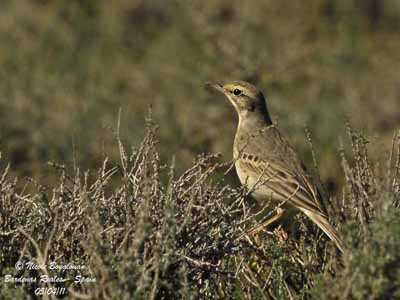
Fr: Pipit rousseline
All : Brachpieper
Esp : Bisbita Campestre
Ital: Calandro
Nd: Duinpieper
Sd: Fältpiplärka
Photographers :
José Luis Beamonte
Pájaros de España
Nicole Bouglouan
PHOTOGRAPHIC RAMBLE
Texte de Nicole Bouglouan
Sources :
HANDBOOK OF THE BIRDS OF THE WORLD Vol 9 - by Josep del Hoyo - Andrew Elliot - David Christie - Lynx Edicions - ISBN: 8487334695
THE HANDBOOK OF BIRD IDENTIFICATION FOR EUROPE AND THE WESTERN PALEARCTIC by Mark Beaman, Steve Madge - C.Helm - ISBN: 0713639601
Pájaros de España (JL Beamonte)
Wikipedia, the free encyclopaedia
Tawny Pipit
Anthus campestris
Passeriforme Order – Moticallidae Family
BIOMETRICS:
Length: 16-17 cm
Weight: M: 29g – F: 28 g
DESCRIPTION:
The Tawny Pipit often adopts typical erect stance.
Both sexes are similar, but the male is brighter than the female. The upperparts are sandy-brown, with streaked crown. The rest of the upperparts is uniform except the wing coverts which are finely streaked darker brown. The rump is brown, and the very long tail is dark brown to blackish on median rectrices. The other tail feathers show narrow buff edges, and the outer ones are edged whitish on both sides.
The breast is sometimes slightly streaked, but usually, it is buff as flanks. The belly is paler.

Above the eye, we can see a pale eyebrow extending from the bill base to the hind crown. Chin and throat are yellowish or whitish. The bill is dark brown with slightly paler lower mandible. The long legs are yellowish. Eyes are blackish-brown.
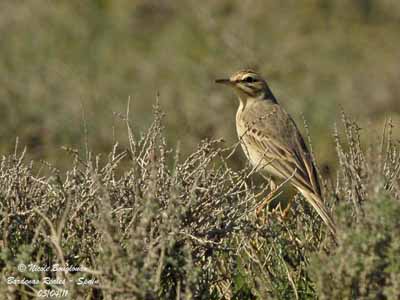
The juvenile is heavily streaked on the upperparts and the upper breast. It shows a conspicuous white wing bar.
There are three subspecies which differ in intensity of plumage coloration and pattern.
VOICE: SOUNDS BY XENO-CANTO
The Tawny Pipit sings loudly. The sound is uttered in high-pitched raspy tones. It is very variable but it can be heard from some distance, even when the bird is flying high in the air.
When threatened, it gives a sharp and prolonged “tzirrrp” or “tchiiiip”.
It sings during the flight displays, raising silently and descending while uttering high-pitched and monotonous, but melodious “chiui-chiui-chiui”.
The Tawny Pipit starts to sing in early April, when arriving at its breeding territory, and it becomes quieter through July.
HABITAT:
The Tawny Pipit frequents bushy areas, dry meadows, cultivated areas, sandy dunes and sandy shores, semi-arid highlands, mountainous slopes, fallows and heath lands.
RANGE:
The Tawny Pipit winters in sub-Saharan Africa. It is present in Europe except Scandinavia, Iceland, Great Britain, and NW France.
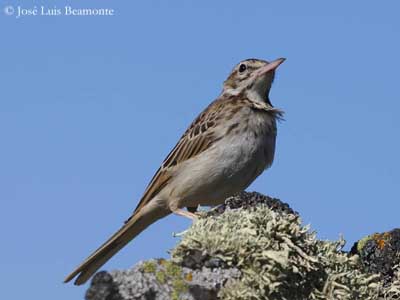
BEHAVIOUR:
The Tawny Pipit walks and runs rapidly on the ground. When alarmed, it flicks its tail up and down.
It alights very often in open. It can be seen in small groups of 3-5 birds in autumn, but at some distance from each other.
It feeds on the ground, running and picking around. It may jump to catch a flying insect, but it rarely pursues them in flight. The largest preys are beaten against a hard surface to dismember them before to swallow them.
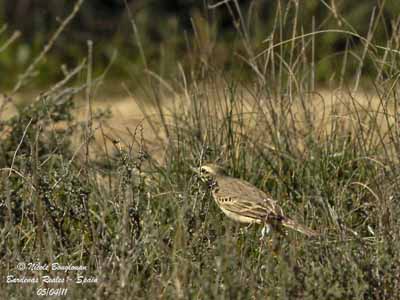
The Tawny Pipit is usually solitary, and outside the breeding season, the members of a pair are rarely together. The species is monogamous and territorial.
The aerial displays at about 30 metres or more in the air are accompanied by songs, while it circles in undulating way. It descends abruptly or glides while singing.
The Tawny Pipit is migratory and winters in sub-Saharan Africa, mainly in the Sahel zone and the Nile Valley.
FLIGHT:
The Tawny Pipit starts to display from a stone, the ground or a small scrub, and returns to the same place if not disturbed. It has undulating flight during the displays.
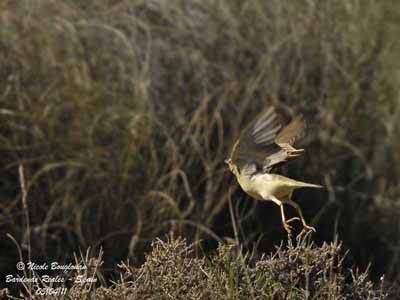
REPRODUCTION:
The Tawny Pipit nests on the ground in shallow depression and often sheltered by the vegetation. The female builds a loose rounded nest with dry grasses, and lined with grass and hair.
She lays 4-5 yellowish-white or greyish eggs, always with dark brown, purple or black speckles and small patches. The incubation lasts about 13-14 days, probably by both parents but mainly by female, as to feed the chicks.
At hatching, the chicks are covered in long, thick pale buff down. They leave the nest within two weeks, sooner if disturbed, and disperse among the rocks and the mounds, but they are always fed by both parents during more than one week, until they can fly. They will be independent at about 4-5 weeks of age.
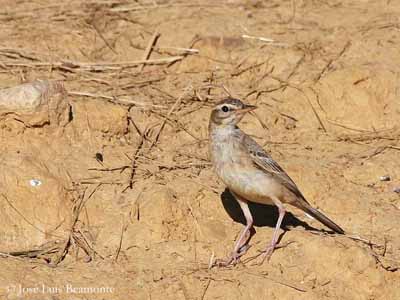
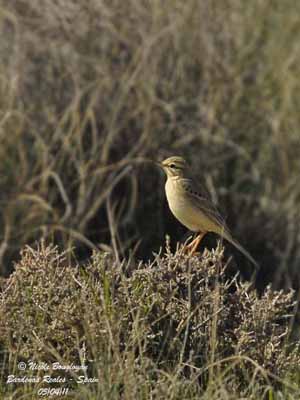
DIET:
The Tawny pipit feeds on various insects, small spiders, worms, small seeds and grasshoppers. It forages on the ground by walking and running fast.
PROTECTION/THREATS/ STATUS:
The Tawny Pipit is fairly common in most part of the range. In west and centre Europe, the species has suffered habitat loss.
But the populations are not currently threatened.